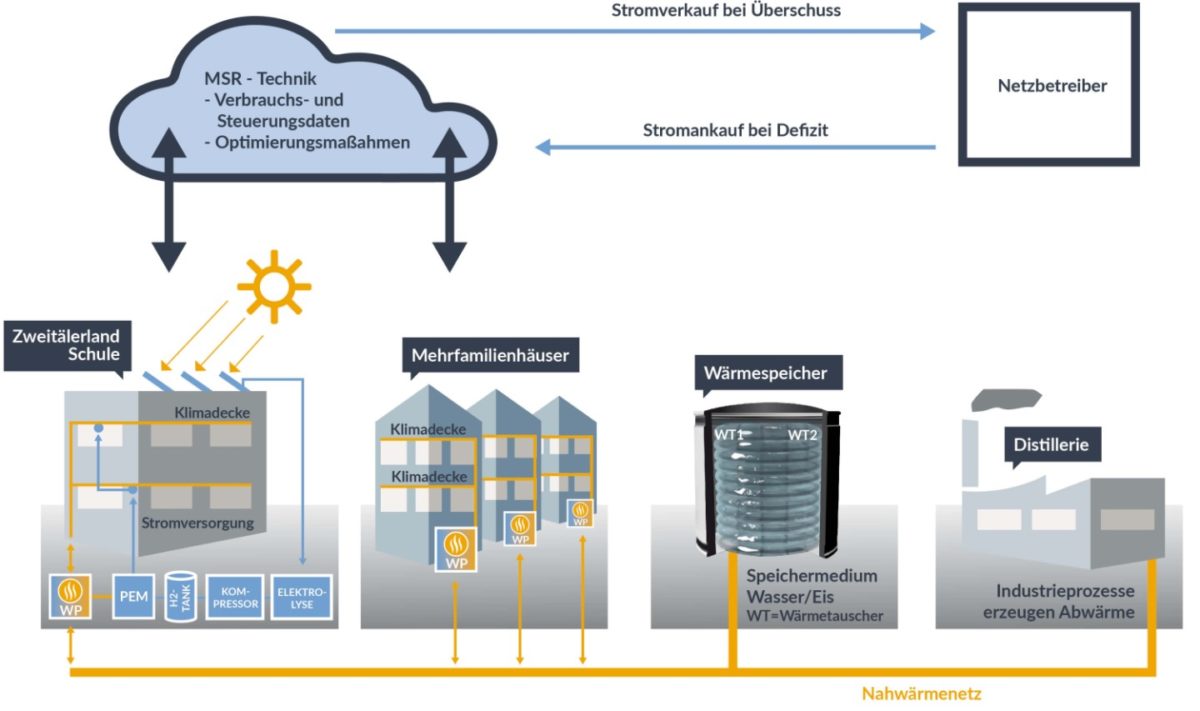Scientists at Germany's Fraunhofer Institute for Solar Energy Systems ISE are developing a research project to evaluate how a small municipal district could be provided with heat by solar-powered heat pumps that use waste heat from a distillery at low temperature levels.
“A PV installation will generate a significant share of the power to drive the heat pumps and we are thinking about optimizing PV self-consumption by a small electrolyzer unit,” researcher Constanze Bongs told pv magazine.
The PV system should be able to produce 95 MWh annually, of which around 20% will be used to provide the school with electricity. The electrolyzer unit will produce hydrogen for loss-free storage, which can then be converted back into electricity in winter. The waste heat generated in the process can also be used to heat the school. A significant share of the electricity consumed by the school, the heat pumps and the heating system can be provided by the PV installation based on a yearly balance.
The heat supply is for a school and several multi-family buildings in the municipality of Gutach in Breisgau, southwestern Germany. In the proposed system configuration, the heat demand of the school and the multi-family apartment buildings is met by a heat pump system that uses industrial waste heat from the Elztal distillery, which is located nearby, and heat from ground water wells as low-temperature heat sources. This heat is injected into an ice storage tank to which heat pumps are connected on the source side.
“Heat is transported by pumping water via a 200 m underground tube from the distillery to the ice storage tank,” the project manager, Wolfgang Kramer, told pv magazine. “The PV system produces electricity independently from the pumping demand.”
Climate ceilings will be installed instead of conventional radiators. This is expected to allow the efficient operation of the heat pump system by lowering the flow temperatures in the heating system.
Popular content
The final design of the system has not been outlined so far. “Therefore, overall efficiencies are not defined, yet,” Kramer added, noting that the heat pump will provide heat and also at least a certain share of domestic hot water.
An energy management system (EMS) will be used to offer additional system services such as control power or the purchase of electricity in the event of negative electricity prices. “Forecast-based control algorithms are being developed and tested for grid-serving operation,” Bongs explained.
Kramer said the system could be an interesting solution for other applications if low-temperature waste heat is available. “It should be in operation in 2023 and evaluated by 2024,” he said.
*The article was updated to reflect that the annual production of the system is 95 MWh and not 95 GWh as we previously reported.
This content is protected by copyright and may not be reused. If you want to cooperate with us and would like to reuse some of our content, please contact: editors@pv-magazine.com.



4 comments
By submitting this form you agree to pv magazine using your data for the purposes of publishing your comment.
Your personal data will only be disclosed or otherwise transmitted to third parties for the purposes of spam filtering or if this is necessary for technical maintenance of the website. Any other transfer to third parties will not take place unless this is justified on the basis of applicable data protection regulations or if pv magazine is legally obliged to do so.
You may revoke this consent at any time with effect for the future, in which case your personal data will be deleted immediately. Otherwise, your data will be deleted if pv magazine has processed your request or the purpose of data storage is fulfilled.
Further information on data privacy can be found in our Data Protection Policy.